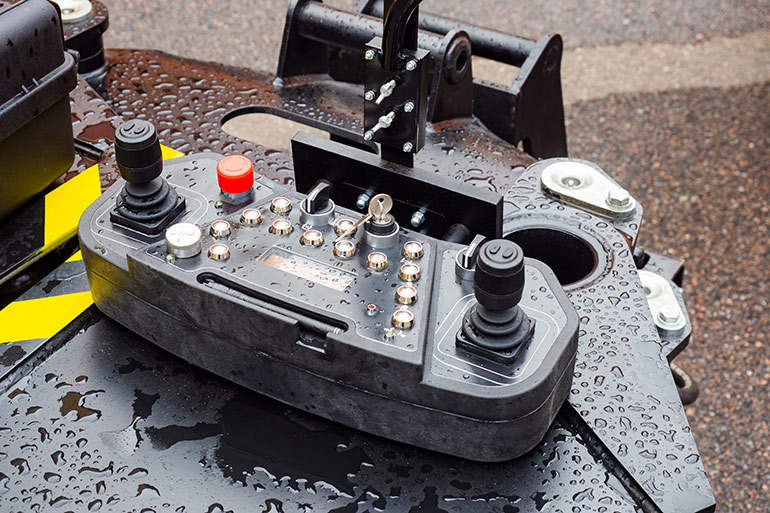By Josh Cosford, Contributing Editor
When specifying belly box remote controls for mobile hydraulic machines, considering all the possible factors improves both operational efficiency and user safety. Belly box remote controls, often used in crane trucks, stone slingers, and other mobile hydraulic systems, provide the operator with wireless control over the machinery from a safe distance with often improved sightlines.

The first step is to assess the machine’s hydraulic functions that need remotely controlled actuation. Hydraulic systems often manage multiple functions, such as lifting, rotating, extending, and retracting. Each function might involve one or more actuators (e.g., cylinders, motors), so it’s essential first to determine how many actuators are used as well as the type of outputs.
Whether the system includes proportional or discrete control functions will impact not only the remote control and receiver selection but also the electronic control unit. Proportional control requires more advanced analog joystick-based systems, while on/off functions can be controlled with simple switches.
The operational range of the wireless remote is also a critical factor in specification. For mobile hydraulic machines, operators often need to maintain control from a significant distance, such as with concrete pumping boom trucks. Typically, belly box remotes offer control from distances between 100 and 300 feet, depending on sightlines, so be sure to specify based on the maximum distance the operator will be from the machine.
You will need to choose a system that operates on the appropriate RF band (e.g., 900 MHz or 2.4 GHz) to avoid interference with other wireless systems. Ensure compliance with local regulations regarding frequency use, especially in areas with strict RF licensing requirements.
Belly box controls come in various designs, from simple switch-based layouts to complex joystick configurations. Choose based on operator ergonomics and the machine’s complexity so that the operator can intuitively interact with the controls and, subsequently, the machine. Manufacturers offer custom layout options, and it might help to defer to the machine operator for advice on that layout.
For machines with multiple axes of movement, such as cranes or loaders, multi-axis joysticks provide smooth and proportional control. Also consider compound functions, such as when a boom might extend or retract while also moving up/down/left/right. You’d want to select a layout suitable for two-handed operation spaced on either end of the box rather than those functions placed where they crowd each other.
For simpler machines with discrete control needs (e.g., on/off functions), buttons or toggles may suffice. Rotary dials, rocker switches, toggles, push buttons, and even jet fighter-style missile switches are all excellent options. It often helps to choose a variety of switchgear to prevent accidental operation of similar-looking rockers or buttons.
Some remote controls come with displays or feedback features, providing the operator with real-time data on machine status, such as load weight, hydraulic pressures, or system diagnostics. Touch screens are also making inroads, where you can now configure electronic buttons specific to users.
Mobile hydraulic machines often operate in harsh environments, so the belly box must be rugged and weather-resistant, so specify a belly box with an appropriate IP protection rating. For outdoor and heavy-duty applications, an IP65 or higher rating is recommended, ensuring protection against dust, dirt, and water ingress.
Remote controls typically operate on rechargeable batteries, and you’ll want a remote with long battery life, especially if extended operation is required in remote areas where charging may be limited. Lithium-ion is the norm, and batteries are rated by milliampere hours and know that more is better. Better yet, select a belly box with swappable batteries.
Safety is paramount in controlling heavy machinery. Specify belly box remotes that feature an easily accessible e-stop button to immediately halt all machine functions in case of an emergency. The system should have a failsafe mechanism that automatically stops the machine if the signal is lost or the control is turned off. The last thing you’d want is a runaway operation to be maintained with a dead battery.
Specifying the right belly box remote control for mobile hydraulic machines involves a thorough understanding of both the machine’s functional requirements and the environmental conditions in which it will operate. Consider the number and type of functions, wireless communication needs, control interface preferences, and durability requirements. These factors will ensure safe, reliable, and efficient operation.
Filed Under: Components Oil Coolers, Controls, Mobile Hydraulic Tips, Related Technologies